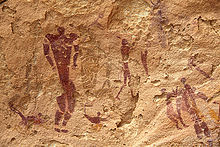Swimmers' den
The Swimmer's Cave is located in southwest Egypt , near the border with Libya , on the Gilf-el-Kebir Plateau in the Sahara . It was discovered in October 1933 by the Hungarian researcher Ladislaus Almásy (László Ede Almásy). It contains cave paintings of floating figures believed to have been made at least 4,000 years ago.
During the 1933 expedition, Almásy Gilf roamed Kebir and the Uwainat Mountains as far as Sudan . The discovery of these and other prehistoric rock carvings in Ain Dua , Karkur Talh and Wadi Sora was the most important result of the expedition.
Almásy dedicated a chapter to the cave in his 1934 book Unknown Sahara . In it he postulates that the swimming scenes are real images of life at that time and that consequently a climate change must have taken place in the period after their creation. This theory was so novel that its first editor added several footnotes in which he did not share this view.
The cave is a central location in the novel The English Patient and the film based on it . However, the cave shown in the film is only a replica.
literature
- László Almásy: Unknown Sahara . Original Hungarian title: Az ismeretlen Szahara . 1934.
- Ladislaus E. Almasy: Swimmer in the desert. In search of the Zarzura oasis . DTV, Munich 1998, ISBN 3-423-12613-2 .
Web links
- Jochen Duckeck: The Cave of Swimmers. In: www.showcaves.com . November 9, 2007, accessed May 12, 2008 .
- Marie Theresa Bray: People followed the rains in ancient Sahara. In: Cosmos magazine. July 21, 2006, accessed May 12, 2008 .
- András Zboray: The Libyan Desert homepage. Fliegel Jezerniczky Expeditions, accessed May 12, 2008 .
Coordinates: 23 ° 35 ′ 41 ″ N , 25 ° 14 ′ 0 ″ E
